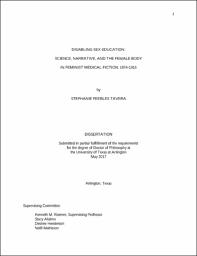
ATTENTION: The works hosted here are being migrated to a new repository that will consolidate resources, improve discoverability, and better show UTA's research impact on the global community. We will update authors as the migration progresses. Please see MavMatrix for more information.
Show simple item record
| dc.contributor.advisor | Roemer, Kenneth M. | |
| dc.creator | Tavera, Stephanie P | |
| dc.date.accessioned | 2019-07-10T00:12:03Z | |
| dc.date.available | 2019-07-10T00:12:03Z | |
| dc.date.created | 2017-05 | |
| dc.date.issued | 2017-05-05 | |
| dc.date.submitted | May 2017 | |
| dc.identifier.uri | http://hdl.handle.net/10106/28346 | |
| dc.description.abstract | This dissertation offers a feminist disability theory approach to women’s medical fiction during the Comstock Law Era. I argue that, in responding to Comstockian censorship, women authors of medical fiction resisted sexed and gendered narratives in late nineteenth- and early twentieth-century sex education discourses, but in so doing, they recast the female body within disability rhetoric. Using feminist body theorists such as Judith Butler, Anne Fausto-Sterling, Emily Martin, and Elizabeth Grosz, I frame each work of feminist medical fiction within a specific historical nexus before discussing how the authors–Rebecca Harding Davis, Louisa May Alcott, Annie Nathan Meyer, and Charlotte Perkins Gilman–rescript the scientific vocabulary at their disposal to shift the concept of disability from one female body to another. I find that although their coding techniques were successful, many authors of feminist medical fiction imitated the very rhetoric of disability they resisted in paternal scientific narratives, and which we have inherited in twenty-first century reproductive health and sex education discourses.
Since nineteenth-century women authors of medical fiction anticipate contemporary feminist theorists and disability theorists, studying a genealogy of disability rhetoric in reproductive health and sex education discourses at the fin de siècle opens up a space for imagining how we might rescript scientific narratives in present-day sex education. I call this theoretical move “dismodern feminism,” following Lennard J. Davis’ concept of “dismodernism” which argues for placing disability at the center of postmodern theoretical discourse. Instead of simply using disability as the vector or lens through which postmodernity examines and defines subjects, I suggest using the disabled female body as a starting point for theorizing an intersectional approach to reproductive health and sex education. Authors of feminist medical fiction initiate this conversation not only because they engage disability rhetoric in their literary works by displacing disability from scientific definitions of the female body, but also because this very displacement has cultural implications for actual impaired bodies then and now. Moreover, many of these women authors of feminist medical fiction are well-known figures from nineteenth-century social reform and the American literary canon: Rebecca Harding Davis, Louisa May Alcott, Annie Nathan Meyer, and Charlotte Perkins Gilman. Yet, their medical fiction texts remain largely unknown and understudied among scholars and students. My project seeks to recover these texts which offer a more nuanced approach to early feminist activism and theory, and further, theorize a dismodern feminist sex education approach which draws from historical and contemporary fiction and nonfiction. | |
| dc.format.mimetype | application/pdf | |
| dc.language.iso | en_US | |
| dc.subject | American literature | |
| dc.subject | Women's literature | |
| dc.subject | Medical fiction | |
| dc.subject | Feminist body theory | |
| dc.subject | Reproductive health | |
| dc.subject | Sex education | |
| dc.subject | Disability studies | |
| dc.title | Disabling Sex Education: Science, Narrative, and the Female Body in Feminist Medical Fiction, 1874-1916 | |
| dc.type | Thesis | |
| dc.degree.department | English | |
| dc.degree.name | Doctor of Philosophy in English | |
| dc.date.updated | 2019-07-10T00:12:04Z | |
| thesis.degree.department | English | |
| thesis.degree.grantor | The University of Texas at Arlington | |
| thesis.degree.level | Doctoral | |
| thesis.degree.name | Doctor of Philosophy in English | |
| dc.type.material | text | |
Files in this item
- Name:
- TAVERA-DISSERTATION-2017.pdf
- Size:
- 1.943Mb
- Format:
- PDF
This item appears in the following Collection(s)
Show simple item record


